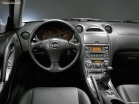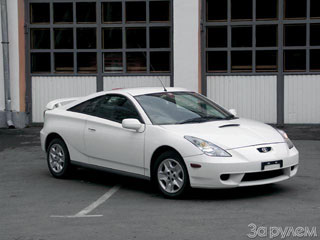Test Drive Toyota Celica 2002 - 2006 Coupe
Long-livers
 Suitable by the end of our Cariniad - from the three in the service in the editorial office of Toyota Karina II, alone remained alone, and that soon we will sell. The purpose of the experiment is to compare the operating costs of the new domestic and equal to the price of the used foreign car - it is achieved, it's time to update the park, for today Karina is the end of the 80s already twice as cheaper than the new VAZ 21103.
Suitable by the end of our Cariniad - from the three in the service in the editorial office of Toyota Karina II, alone remained alone, and that soon we will sell. The purpose of the experiment is to compare the operating costs of the new domestic and equal to the price of the used foreign car - it is achieved, it's time to update the park, for today Karina is the end of the 80s already twice as cheaper than the new VAZ 21103. So four years ago, bumping Lihu with a used Volkswagen-Passat (it was a whole epic - with wasting, technical inspections and chronic failure of the brake amplifier), we decided to buy a car, which is called, without problems. Having extensive sources of information from owners and specialists from all over Russia and from abroad, we agreed that Japanese cars deserve to the greatest degree of this title, and among them Toyota.
 An eight-year-old karina color wet asphalt bought on the road, another pre-crisis price - $ 7,600 and this time chose a car with Moscow numbers and PTS. As it turned out, the power of Japanese is not only in durability - in order to feel the difference with German (by the way, the peer and classmate), it turned out to be enough to drive the first ten meters or even just open and close the door. Despite the fact that Toyota lived his youth in crude Holland, the condition of the body was excellent, and the motor worked about 150 thousand km, was quite fresh. In general, given the then high cost of used foreign cars (the new Vaz 21093 in 1997 was worth the same $ 7600), believed that we were lucky with the purchase.
An eight-year-old karina color wet asphalt bought on the road, another pre-crisis price - $ 7,600 and this time chose a car with Moscow numbers and PTS. As it turned out, the power of Japanese is not only in durability - in order to feel the difference with German (by the way, the peer and classmate), it turned out to be enough to drive the first ten meters or even just open and close the door. Despite the fact that Toyota lived his youth in crude Holland, the condition of the body was excellent, and the motor worked about 150 thousand km, was quite fresh. In general, given the then high cost of used foreign cars (the new Vaz 21093 in 1997 was worth the same $ 7600), believed that we were lucky with the purchase. After all in turn ride and exchanged delights, labor weekdays began for Karina. Over the next four years, she ran 100 thousand km, refuting the situation that the inevitable replacement of the resource of parts allegedly the hard burden falls on the owners of foreign second-hand ... In fact, the costs of spare parts were only $ 608 (see Table 1) . Yes, it is much more expensive than a similar set of parts for the VAZ 21093, but compared with the fuel costs are insignificant. Even if we always went on gasoline (we recall: on the first Toyota there were gas-filled equipment), spent on parts of dollars would scold, saving fuel, about 1.5 l / 100 km compared to carburetor nine. By the way, we sold Karina for the same $ 2000, which now can be realized for the VAZ 21093 1997.
 So account equal? Is it really considering $ 2,200 on gasoline and oil, four years old shaking on the VAZ rattle would have cost the same $ 8000 (that is, $ 0.08 per kilometer), as the enjoyment of a foreign car? E, no - smaller optimism! And who will count the clutch discs, thermostats, sensors, relays, shruses, etc., that would require the nine for this mileage? And how much would regular visits cost the service? And Lytra Tosola, spilled on the road with fan failures? And in general, 100 thousand km - sometimes, too much for the motor of modern nine. Without a overhaul ($ 200), most likely, do not do ... Yes, and the box would have to once and another to go through, but to repaint the car for sale - the usual thing, otherwise who will buy it? .. in short, you throw it a couple of thousand thousand Dollars: Approximately we saved Toyota - the car without problems.
So account equal? Is it really considering $ 2,200 on gasoline and oil, four years old shaking on the VAZ rattle would have cost the same $ 8000 (that is, $ 0.08 per kilometer), as the enjoyment of a foreign car? E, no - smaller optimism! And who will count the clutch discs, thermostats, sensors, relays, shruses, etc., that would require the nine for this mileage? And how much would regular visits cost the service? And Lytra Tosola, spilled on the road with fan failures? And in general, 100 thousand km - sometimes, too much for the motor of modern nine. Without a overhaul ($ 200), most likely, do not do ... Yes, and the box would have to once and another to go through, but to repaint the car for sale - the usual thing, otherwise who will buy it? .. in short, you throw it a couple of thousand thousand Dollars: Approximately we saved Toyota - the car without problems. The second carin of the color of beige metallic bought, of course, under the influence of the first, but in need, about which later I regretted. No, the car itself was almost in perfect condition, it was just a matter immediately after a default, when the sellers on inertia continued to break prices. Well, seven thousand are, of course, too, and 4500 was considered acceptable - it was very good for Karina in the luxury configuration brought from Germany.
It so happened that in two years of work in the editorial office, it passed only 12 thousand km, so the final losses in the sale in November 2000 were pretty great. After folding $ 4500 with costs for gasoline and oil - $ 300 and adding 300 more on parts (see Table 2), and then deduge $ 2,200 paid to us by the new buyer, we get $ 2500. Thus, silence, comfort and merchantness of used Japanese cost about $ 0.2 per kilometer. This is clearly more than a new nine or a dozen would eat, although twice as smaller than the new foreign car of the same class. (For example, Nissan Maxim Transjiril $ 0.4 / km - see SM, 2000, No. 10.) Eh, the having to do with the purchase of the second Toyota of the month of four, it would cost a third cheaper, and a kilometer would cost the cents ten ...
The third sister in the family of Karin acquired already after a careful study of the market. Initially, instead of it planned similar to the aggregates and as reliable, but more compact Corolla. However, the situation on the market forced to refuse the C-class popular in Europe - the owners of such machines, as a rule, are not good and attached, so they put their car for sale like some kind of treasure, trying to return almost all the amount invested in it. And the larger voicers, trade winds, karins and chords buy rather wealthy people changing cars often and, of course, on new - from here an excess D-class in the secondary market and reasonable prices. In Russia, by the way, the same. Slightly spilled yesterday's Zhigulists, having bought the first in the life of a foreign car (Daewoo Nexia, Skoda Felicia, Hyunda emphasis, etc.), subsequently hold a circular defense on the market, voluntarily giving up potential buyers to more accurate owners of large and luxurious Clars, Condor, Sonatov.
So we, leaving the sellers of the five thousandths Corolla and further wake over their gratuit, looked at a silvery carin with a body of Liftbek. Understanding that such cars in advertising newspapers are slightly more than buyers, the owner politely moved to $ 3,000. The survey showed that nothing serious he had time to break, and before him, in Germany, the car, apparently, was serviced as it should be.
 Lowing the car in order for $ 300 (windshield, pads, cables), since then we have been buying only consumables. The car was converted to inexpensive fuel filters (ready to tell about it more). Oil - that the femo is that the champion is worth $ 6, and they do not disappear from the counters, but the air deficit. Found the original $ 16 - of course, not on the service, but at a small dealer, buying Japanese spare parts in the Arab Emirates, where they are twice as cheaper.
Lowing the car in order for $ 300 (windshield, pads, cables), since then we have been buying only consumables. The car was converted to inexpensive fuel filters (ready to tell about it more). Oil - that the femo is that the champion is worth $ 6, and they do not disappear from the counters, but the air deficit. Found the original $ 16 - of course, not on the service, but at a small dealer, buying Japanese spare parts in the Arab Emirates, where they are twice as cheaper. Half a year ago, for the first time, the Candles Q16R-U candles were bored for our carin - immediately set, although worked less than 10 thousand km. En-Ji (NGK) also showed themselves perfectly. One hundred percent transmission synthetics of liquidi-moths, sprinkled in the gearbox immediately after buying the car, will replace, probably, only the future owner is the loss of zero, the crankcase outside is absolutely dry. But the engine oil was changed already twice - since the part of the editorial park was transferred to the firm of Motul, the remaining Karina also rides at a sports 300V viscosity 15W50. So that nozzles are not clogged with resins, gasoline AI-95 fill only on proven columns. However, on the eve of winter, the system was prophylated on the service (read more about this procedure in SM, 2000, No. 6, p. 136). As soon as the propeller of the company Vince, circulating in the fuel ramp, drove resinous sediments through the nozzles, the motor, before that, worked flawlessly exactly, suddenly shook and sometimes even Gloh, forcing it again and again. Only in twenty minutes, when he calmed down and froze, quietly rustling pistons, it became clear that the entire dirt was dye in the flushing filter or burned in the cylinders.
To summarize the operation of the third carin after 14 thousand km is still early - we will sell, then we calculate. But now it is clear that the silver went to the record - so cheap, as on it, you can ride, perhaps, only on OK, and that is short. But the main thing, this Toyota, released 12 years ago, is a dumb reproach to the Russian automotive industry. Every year, without preparation and bribes, passing tool control (CO - 0.18%), spacious, like a Volga, the Japanese old woman develops 185 km / h, burning on average about 6 liters of gasoline by 100 kilometers ...
Rog the nozzles better on the service.
Text / Anton Utkin
A source: Journal "Behind the wheel"








